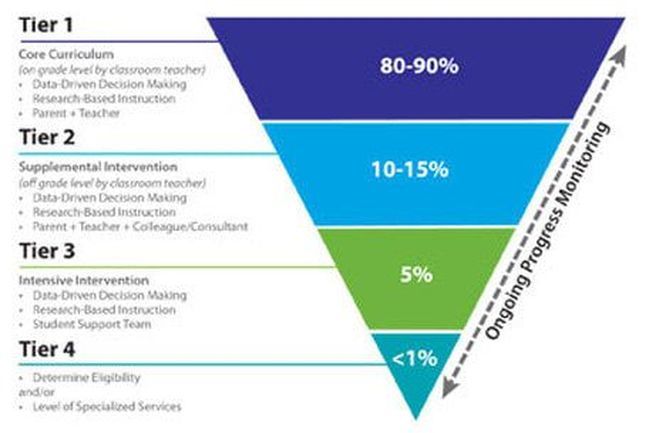
UNIVERSAL INSTRUCTION- TIER I
At the Universal instructional level all students receive high quality scientific, research-based instruction from general education teachers in the core curriculum. Instruction in the core curriculum includes all developmental domains including behavioral and social development along with instruction in academic content areas. The core curriculum provides the foundation for instruction upon which all Targeted and Intensified interventions are formulated. Universal instruction is differentiated, culturally responsive, and occurs in the general education setting. At this level, general education teachers match students’ prerequisite skills with course content to create an appropriate instructional match and use instructional strategies with fidelity that are evidence-based. Teachers utilize a universal screening tool to screen all students a minimum of three times per year to measure progress toward grade level expectations. The Universal instructional level typically meets the needs of approximately 80-90% of the student body.
TARGETED INSTRUCTION - TIER II
At the Targeted instructional level, targeted interventions are provided to students who are not achieving the desired standards through the core (academic and behavior) curriculum alone. Targeted interventions supplement the instruction in the core curriculum provided in universal instruction. They should be based on the identified needs of the student as determined by the data gathered and stated in an intervention plan. Selecting the appropriate targeted interventions should be made with a team of educators and upon a student’s need for targeted interventions. Targeted interventions are intended to be short-term in duration and are in place for immediate implementation. Interventions are generally provided in small groups and may occur in the main classroom or in other settings. Progress monitoring assessment at the Targeted instructional level happens at frequent intervals after interventions have been implemented. The Targeted instructional level typically consists of 5-10% of the student body.
INTENSIFIED INSTRUCTION – TIER III
The Intensified instructional level of support is designed to reduce the severity of chronic academic and/or behavior problems. Students at the Intensified instructional level are those students who are performing significantly below academic and behavioral standards and who have not adequately responded to high quality instruction and/or positive behavior supports provided at the Universal and Targeted levels. Interventions at the Intensified level may either support and enhance instruction provided at the Universal and Targeted levels, or be substituted for a portion of the Universal instruction and Targeted intervention if those interventions have been tried with increased frequency and duration and proven ineffective. Intensified interventions may or may not be supported by special education resources and they need not be synonymous with special education. Progress monitoring assessment at the Intensified level is completed more frequently to assess response to intervention. 1% to 5% of the student body will require this level of support

REFERRAL PROCESS
TITLE 0
Teachers should contact parent and notify them of their concerns for the student. With parental concurrence begin interventions and documentation for at least a few weeks prior to referral unless the student’s needs are so significant to warrant immediate referral.
Referring teacher obtains the RTI Form from website. There is a form specifically designed for academics and behavior (Exhibit A) and a different form for speech and language concerns (Exhibits B).
Referring teacher completes the form in detail with supporting documentation and returns it to the RTI Coordinator, Department of Programs and Interventions.
RTI Coordinator will contact the referring teacher, discuss the referral or obtain information that may be relevant.
An initial RTI meeting will be scheduled to review the referral and to determine if sufficient Tier II/III interventions have been implemented and monitored. The team will also discuss additional Tier II/III interventions that may be implemented in the classroom with follow-up, gathering additional data, and student observation.
The meeting agenda is as follows:
Identify concerns
Inventory student strengths and talents
Summary of Tier I and Tier II interventions (include background data, student's current level of performance and Tier I and Tier II interventions)
Define academic and/or behavioral goals (top 1-2 difficulties that most interfere with student's progress)
Design Intervention Plan (include method and frequency of progress monitoring)
Plan for contacting parents/guardian if not in attendance
Review the intervention and monitoring plan
Schedule follow-up meeting
Copies of the referral, meeting minutes and intervention plan will be maintained in the Department of Programs and Interventions.
Follow-up contact is made with the referring teacher and parent/guardian according to the established intervention plan.
A follow-up meeting will be held by the team monthly to discuss the intervention plan and make any necessary changes. Teachers will complete the RTI Follow Up Form for each subsequent meeting.
